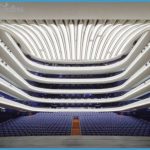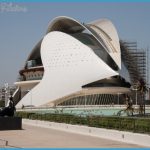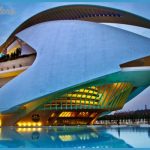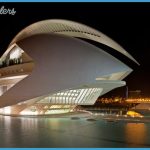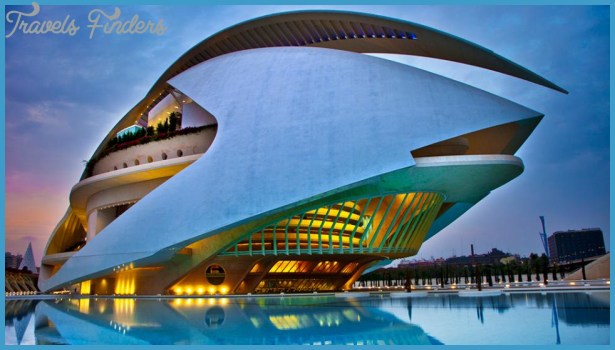SANTIAGO CALATRAVA
One of the sensational buildings of the City of Arts and Sciences in Valencia, the Queen Sofia Palace of the Arts is a large, concrete and steel opera house clad in mosaic. It is renowned for its remarkable, soaring white roof, which might be taken for the giant sculpture of a sea creature in motion. At 246ft (75m) high it is the tallest opera house in the world and contains four auditoria-two of them large (one mainly for opera, and the other for multiple uses) and a couple of smaller performance spaces. From the windows of the opera house spectators can look out through the gaps in the sweeping roof and across the surrounding ornamental lakes and verdant gardens to the other equally flamboyant buildings of the City of Arts and Sciences.
SANTIAGO CALATRAVA
Born in Valencia, Santiago Calatrava studied architecture before moving to Switzerland to study civil engineering. He began his career as a structural engineer, creating bridges and railway stations that became known for their blend of innovative engineering and elegant design. Calatrava is a sculptor and architect, as well as an engineer. He has designed many high-profile public buildings, such as museums, sports complexes, and cultural centers, most of which display an inventive sculptural quality.
The laminated steel roof is covered with mosaic cladding
The roof is poised in mid-air at one end of the building
The building extends below ground level
4 ROOF SHELLS
The opera house is covered by two huge, symmetrical, cutaway roof shells, which arch right over the building, and rest on its base with little visible means of support. The roof shells look thin and fragile, but they are in fact made of laminated steel and weigh around 3,000 tons. Numerous openings in the shells let natural light pour into the building.
4 CONICAL PAVILION
Ancillary structures close to the opera house are designed with just as much care as the main building, often taking an unexpected geometric form and creating an element of surprise. This conical roof covers the entrance to a parking garage near the Palace of the Arts. Like the main roof behind, it is clad with glittering white mosaic.
ON DESIGN
Many of Calatrava’s bridges are variations on the cable-stayed bridge, in which structural cables usually extend from either side of a central upright pylon down to the bridge deck. Calatrava adapted this design by placing the pylon to one side and slanting it, then running the cables from one side only, to create a structure that looks like a harp. The pylon is filled with cement so that it counterbalances the weight of the bridge deck.
Calatrava has also built other innovative bridges, including tied-arch bridges and a suspension bridge that rotates to allow ships to pass. Their sculptural forms, usually in gleaming white, have become landmarks and are often imitated by other engineers and architects.
1 Alamillo Bridge, Seville, Spain
This bridge, completed in 1992, has a 656-ft (200-m) span. It is held up by a single cantilevered pylon set at an angle of 58 degrees and 13 steel cables.
1 MOSAIC CLADDING Calatrava created the roof’s shimmering white by cladding it with trencadis, a traditional form of mosaic made from fragments of ceramic tile that was popular with earlier Spanish architects, such as Antoni Gaudi. In a gesture of architectural daring the point of the roof shell is suspended in mid-air.
3 MAIN HALL Operas (as well as occasional symphony concerts and plays) are staged in the main hall, the largest auditorium, which seats up to 1,800 people. The unusual curve of the balconies, the lines of the soaring ceiling, and the gleaming white finishes bear a striking resemblance to the features of the building’s exterior.
ON SITE
In 1957 a devastating flood hit Valencia. To prevent further flooding, the Turia River, which ran through the center of the city, was diverted and the former riverbed was made into a huge public park. This later became the site of the City of Arts and Sciences. Construction began in 1996 under the direction of Calatrava. The complex contains several buildings by Calatrava himself, including L’Hemisferic, which contains an Imax cinema and digital projection, and an interactive Science Museum. L’Oceanografic, the largest aquarium in Europe, was designed by Felix Candela, another Spanish architect. These avant-garde buildings all share the curving geometric shapes of the Palace of the Arts.Hemisferic
This building contains a 9,690-sq ft (900-sq m) concave screen. It has a hemispheric dome and, seen from the side, it looks like a huge human eye.

